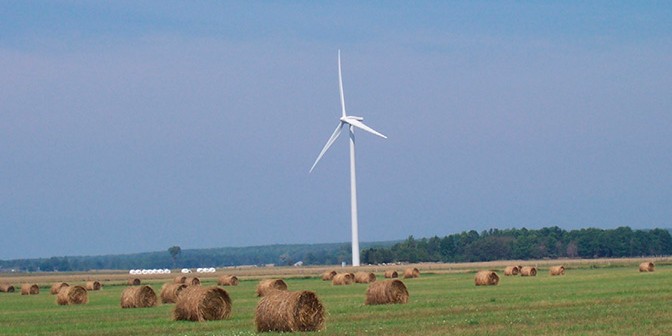Portland, Ore., February 9, 2016 — Oregon households and businesses will keep more money in their pockets if the state continues to grow wind energy resources, according to new data released by the American Wind Energy Association (AWEA) and the Wind Energy Foundation (WEF).
The new data underscores the opportunity presented by a current legislative proposal to raise Oregon’s renewable portfolio standard (RPS) to 50 percent by 2040, up from the current standard of 25 percent by 2025. State RPS policies help create a more diverse electricity mix while keeping the lights on and creating major consumer savings.
“Increasing the state’s RPS to 50 percent by 2040 would be a key and big step in making this vision a reality and would be critical hallmark in Oregon’s clean energy leadership,” said Tom Darin, Western State Policy Director for AWEA. “The Wind Vision findings show wind energy is a win-win option for the Oregon — cutting carbon pollution goes hand-in-hand with billions in ratepayer savings.”
The new estimates come from calculations made by AWEA using data from the U.S. Department of Energy’s 2015 report Wind Vision: A new era for wind power in the United States. According to the report Oregon can save more than $2.35 billion on consumers’ electricity bills through 2050 by achieving the Wind Vision growth scenario.
“With stable policy we can grow wind energy and save Oregon homeowners and businesses money,” said Tom Kiernan, CEO of AWEA. “Because of American ingenuity, wind energy’s costs have dropped by 66 percent in just the last six years, and by continuing to invest in wind over two billion dollars in savings can be passed on to Oregon consumers.”
According to the Wind Vision, wind energy can double from supplying nearly five percent of U.S. electricity demand today to 10 percent by 2020, 20 percent by 2030, and 35 percent by 2050, making wind the leading source of electricity in the U.S. Other economic benefits for Oregon that can come from greater wind energy use include $48 million in annual property tax revenue and almost $22 million in annual wind farm lease payments to landowners by 2030.
Wind energy supplies more than 12 percent of Oregon’s in-state electricity production. Wind Vision shows Oregon wind energy alone could supply nearly 37 percent of the state’s electricity by 2030, enough to power the equivalent of two million American homes.
Including Oregon, nine states already rely on wind power to provide 12 percent or more of their state’s electricity production. Wind can reliably supply even larger amounts of electricity according to a report by the utility consultant The Brattle Group; wind has at times supplied as much as 40 percent of the electricity on the main Texas grid, and 60 percent on the main utility system in Colorado.
Adding more wind energy also protects consumers against fossil fuel price spikes because utilities can lock-in fixed rates for zero fuel cost wind, lowering consumer electricity bills as a result.
“It’s your energy version of a 30-year fixed rate mortgage that will provide price stability for consumers and ultimately save them $2.3 billion – a fantastic return on investment,” said John Kostyack, Executive Director of WEF. “The study clearly shows the benefits of wind that Oregon citizens are already enjoying. It also shows that wind energy can provide an even bigger economic boost in the coming decades.”
A recent national report from Lawrence Berkley National Lab and the National Renewable Energy Lab show that renewable energy projects built to fulfill state RPS policies resulted in billions of economic and environmental savings, and led to the creation of more than 200,000 jobs nationwide.
In Oregon, wind power supports nearly 2,000 jobs, including well-paying manufacturing jobs at 10 factories producing wind power components around the state. Wind energy has already attracted $6.2 billion in capital investment to Oregon, and rural landowners currently receive $9.5 million a year in land lease payments.
The Wind Vision reports that more than 380,000 well-paying jobs can be created across the country by wind meeting the 20 percent wind scenario by 2030, up from 73,000 jobs today. That includes 142,000 manufacturing jobs by 2030, up from the nearly 20,000 wind manufacturing jobs today.
Expanding wind energy can also help Oregon avoid 10 million metric tons of carbon pollution per year by 2030 according to the new data, the equivalent of more than 2 million cars’ worth of carbon emissions every year.
Emerging opportunities to invest in the rapid growth of the U.S. wind energy industry will be on full display at this year’s WINDPOWER 2016 in New Orleans from May 23 – May 26. The event is the Western Hemisphere’s largest annual wind power trade show.
AWEA is the national trade association of the U.S. wind energy industry, with 1,000 member companies, including global leaders in wind power and energy development, wind turbine manufacturing, component and service suppliers, and the Western Hemisphere’s largest wind power trade show, the AWEA WINDPOWER Conference & Exhibition, which takes place next in New Orleans, LA, May 23-26, 2016. AWEA is the voice of wind energy in the U.S., promoting renewable energy to power a cleaner, stronger America. Look up information on wind energy at the AWEA website. Find insight on industry issues at AWEA’s blog Into the Wind. Join AWEA on Facebook. Follow AWEA on Twitter.
The Wind Energy Foundation is a non-profit organization that recruits, trains and mobilizes business voices to education the American public and decision makers about the benefits of wind energy and other renewable energy. This work helps secure the policies needed to accelerate the nation’s transition to clean, domestic and affordable renewable energy.





